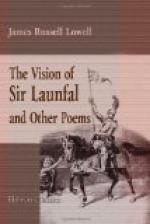314. Softer: Lowell originally wrote “calmer” here. The change increased the effect of the alliteration. Was it otherwise an improvement?
315. Lo, it is I: John vi, 20.
316. Without avail: Was Sir Launfal’s long quest entirely without avail? Compare the last lines of Tennyson’s Holy Grail, where Arthur complains that his knights who went upon the Holy Quest have followed “wandering fires, lost in the quagmire,” and “leaving human wrongs to right themselves.”
320, 321. Matthew xxvi, 26-28; Mark xiv, 22-24.
322. Holy Supper: The Last Supper of Christ and his disciples, upon which is instituted the communion service of the churches. The spirit of the Holy Supper, the communion of true brotherhood, is realized when the Christ-like spirit triumphs in the man. “Inasmuch as ye have done it unto one of the least of these, my brethren, ye have done it unto me.” (Matthew xxv, 40.)
326. The original has “bestows” for “gives.”
328. Swound: The antiquated form of swoon.
332, 333. Interpret the lines. Did the poet have in mind the spiritual armor described in Ephesians vi, 11-17?
336. Hangbird: The oriole, so called from its hanging nest; one of Lowell’s most beloved “garden acquaintances” at Elmwood. In a letter he says: “They build a pendulous nest, and so flash in the sun that our literal rustics call them fire hang-birds.” See the description in Under the Willows beginning:
“My oriole, my glance of summer fire.”
See also the charming prose description in My Garden Acquaintance.
338. Summer’s long siege at last is o’er: The return to this figure rounds out the story and serves to give unity to the plan of the poem. The siege is successful, summer has conquered and entered the castle, warming and lighting its cold, cheerless interior.
342, 343. Is Lowell expressing here his own convictions about ideal democracy?
THE SHEPHERD OF KING ADMETUS
Apollo, the god of music, having given offense to Zeus, was condemned to serve for the space of one year as a shepherd under Admetus, King of Thessaly. This is one of the most charming of the myths of Apollo, and has been often used by the poets. Remarking upon this poem, and others of its period, Scudder says that it shows “how persistently in Lowell’s mind was present this aspect of the poet which makes him a seer,” a recognition of an “all-embracing, all-penetrating power which through the poet transmutes nature into something finer and more eternal, and gives him a vantage ground from which to perceive more truly the realities of life.” Compare with this poem An Incident in a Railroad Car.
5. Lyre: According to mythology, Apollo’s lyre was a tortoise-shell strung with seven strings.
8. Fagots for a witch: The introduction of this witch element into a Greek legend rather mars the consistency of the poem. Lowell finally substituted for the stanza the following:




